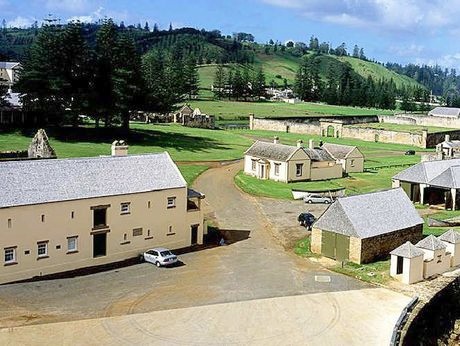
A cemetery brings to mind death, but as I look at this photograph I remember the headstones standing lonely next to the sea on Norfolk Island. The sound of the sea perpetually rolling in; the sound of the birds calling seem to echo the voices of those that once lived here but now lay sleeping under the headstones.
I walk on through the soft grass, threading my way among the gravestones, feeling the heat of the day and pondering the warmth of life that used to be here.
Names catch my eyes and dates of birth and death; I feel the lives that the people lived back as convicts at times past. Very hard times, difficult times, overwhelmingly sad times. The echo of the lash, I hear and recoil at the ferocity that it is given; leaving the convicted one torn, bleeding and hopelessly vulnerable to the man that perpetuates the severe judgement that is carried out.
My husband walks with me amongst the dead, in the warm sun of this beautiful Island. He feels uneasy, he feels angry, and he feels confused. Echoes of the lash ring in his ears also; he feels shame. “Why?”, He asks. Feelings of deja vu grip him, he feels sick to the stomach. It is as if at another time he knew and was the cause of the inhuman treatment of the poor convicted souls. We had to leave.
As we drive back from the Penal Colony to Kingston, John begins randomly calling abuse, such as ‘They ought to bring back the lash!’ and ‘Hang em!’ meaning if the locals find the perpetrator of a murder that has been recently carried out on the Island. It is the first and only murder since Kingston’s early beginnings. He continues his behaviour and language that is so upsetting to me I ask him to stop the car, ‘I want to get out, I cannot stand the energy in here.’
He won’t stop, so I jump out – the car is not going too fast, you can only drive at 15 kph on the Island. A man driving a truck behind us, stops and asks ‘Do you wanna a lift to town luv? I accept at once. John hasn’t seen him and thinks, at first, that I have vanished off the face of the Earth. I feel a rush of energy jump with me out of the car and realise that something has been released.
Back in our rooms we rest and read. I pick up the book purchased the day before. The cover reads Hell and Paradise written by Peter Clarke, who lives on the Island and who was the great, great grand nephew of Marcus Clarke author of the Australian classic ‘For the Term of his Natural Life‘. The book falls open onto my lap and my eyes go straight to a passage stating Sir John Barrow had been the Stipendiary Magistrate at the Penal Colony in the `Hell times’ of Norfolk and much favoured the use of the lash. What stuns us both is my husband’s name is John Barrow and the family have often jokingly called him `Sir.’
On reading the book again all these years later, we cannot find the paragraph that John also read about Sir John Barrow being the Stipendiary Magistrate at the Penal Colony. We have found Samuel Barrow was appointed Stipendiary Magistrate in 1846. See http://www.barrow-lousada.org/samuel%20barrow.htm . He then returned to Hobart in 1849, and later transferred to to Victoria where his last position was Immigration Minister. He died mysteriously by drowning in 1854.
Further research reveals that Sir John Barrow was of the Admiralty for 40 years in U.K. had constantly received all dispatches about the Penal Settlement on Norfolk Island and the Decision of the Pitcairners to be re-established on Norfolk Island. Sir John Barrow, had written a book/study in 1831 of ‘The Eventful History of the Mutiny and Piratical Seizure of H.M.S. Bounty: Its Cause and Consequences, ensured the enduring fame of the Bounty and her people. Sir John Barrow died suddenly on 23rd November, 1848.
Now we have been advised by upstairs, that it is a little complicated, but Sir John Barrow’s spirit walked with Samuel Barrow at the end of his time as the Stipendiary Magistrate at the Norfolk Island Penal Colony to influence Samuel and assist with changes that were to come. The Penal Colony ended in 1855.
In 1856 the Pitcairn Islanders – the descendants of the Bounty Mutineers, landed on Norfolk Island – and this is celebrated once a year. As it happened without planning it, we arrived on the ‘Bounty Day.’ My maiden name is Young and the family is supposed to be distantly connected to ‘Ned Young’ the Midshipman who mutineered with Fletcher Christian.
That put our souls in this life into an opportunity to heal past lives of our DNA ancestors. Interestingly John in this life was articled to his father as a lawyer and his family hoped he would go on to be a barrister because he can ‘think on his feet.’ The Barrow family DNA line have mostly come from Lawyers, Magistrates and Authors.
A short addendum to the story is Justice and Government:
When leaving, we were met at the airport by the lady who rented her house to us. When we told her of our experience with ‘the ghost’ she told us, ‘That’s interesting because while at work today, in the building that is now the Norfolk Island Government Legislative Assembly and Courtroom, I stepped outside to smoke a cigarette and noticed to my horror, that the whole of the outside of the 3 story wall was covered in wriggling grubs. I even fetched my fellow workmates to come and see.’
The building used to be the Old Military Barracks where the Courtroom, administrative and legal functions have been carried out at Kingston since 1856.
To read more about Norfolk Island, go here.

The Penal Colony on Norfolk Island
